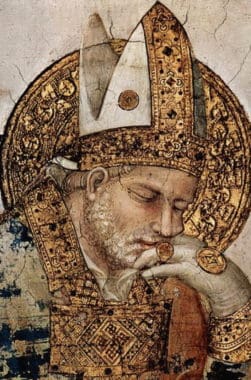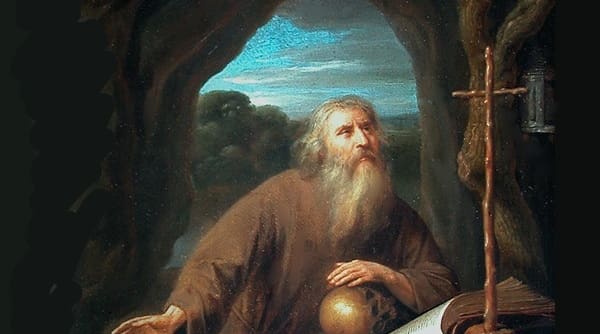Mini-Course on Prayer
Section 2 Christian Meditation
Part 12 – From Meditation to Contemplation
Editor’s Note: In Part 11, David Torkington introduced Christian meditation. Today, he will talk about Lectio Divina, love as the ground of our being, and discuss some aspects of meditation.
In vocal prayer, despite the time given to brief moments of silence, we have been doing most of the talking. However, for prayer to lead on to generate the quality of love that will alone permanently change us for the better, we must learn to listen more. If our spiritual life is to deepen we need to learn to stop talking and listen, to be silent and to allow ourselves to be loved. This is why all authentic Christian prayer begins not by flinging oneself into obscure states of transcendental awareness, but by trying to listen to God’s words as embodied in the words of Jesus Christ. This is how the early Christians used to pray in a method of prayer that later came to be called Lectio Divina or the divine or sacred readings. It was so called, not just because they believed the words they read were inspired, but because they also believed that they too would be inspired by the Holy Spirit as they read them. They believed that through these sacred readings they would be led on and into a sort of profound dialogue with Jesus that would lead them on and into “The love of Christ, which is beyond all knowledge, where we are filled with the utter fullness of God” (Ephesians 3:18-19).
Introducing Guido the Carthusian
 Whatever other methods of prayer we may at times find helpful, we must never forget and always turn back to the Scriptures as the Christian prayer book par excellence. In the Middle Ages, a Carthusian monk called Guido coined four Latin words that have been used ever since to describe the four steps of Lectio Divina or Christian Meditation. They show how they can lead serious-minded Christians onward to experience the love that surpasses all understanding. These Latin words are only used to sum up the way ordinary Christians actually prayed from the earliest of times, enabling people who had not known Jesus personally to love him. The words are Lectio (Reading), Meditatio (Reflecting on what is read), Oratio (Reacting in prayer to the sacred texts), and Contemplatio (Relishing, while reacting in fewer and fewer words, and then in silence, to the love that is experienced). Many of the early Christians knew whole passages, if not all of the Gospels by heart. They had no other prayer books to hand, nor did they have need of them. When the first Christians used the scriptures, most particularly the New Testament, they were not interested in how much they read, but in how deeply they penetrated the sacred texts in their search for wisdom.
Whatever other methods of prayer we may at times find helpful, we must never forget and always turn back to the Scriptures as the Christian prayer book par excellence. In the Middle Ages, a Carthusian monk called Guido coined four Latin words that have been used ever since to describe the four steps of Lectio Divina or Christian Meditation. They show how they can lead serious-minded Christians onward to experience the love that surpasses all understanding. These Latin words are only used to sum up the way ordinary Christians actually prayed from the earliest of times, enabling people who had not known Jesus personally to love him. The words are Lectio (Reading), Meditatio (Reflecting on what is read), Oratio (Reacting in prayer to the sacred texts), and Contemplatio (Relishing, while reacting in fewer and fewer words, and then in silence, to the love that is experienced). Many of the early Christians knew whole passages, if not all of the Gospels by heart. They had no other prayer books to hand, nor did they have need of them. When the first Christians used the scriptures, most particularly the New Testament, they were not interested in how much they read, but in how deeply they penetrated the sacred texts in their search for wisdom.
A Mystical Body full of loving
The wisdom for which they searched was not a body of facts, but a body – a mystical body full of loving, who continues to love now as he did when he was on earth. They would read a few verses at a time going over them for a second and a third time, poring over them, entering more profoundly into their dynamic inner meaning. Then they would pause in moments of deep interior stillness to allow the same Spirit who inspired the scriptures in the first place, to inspire them too, with knowledge and love for the man who had come to redeem them. When they had savoured one particular text, they would reverently move on to another, and then repeat the process, leaving pauses for silence for the impact of the words to seep into the very marrow of their being. As this prayer grew more and more intense, the moments of silence would become more and more prolonged, and as love blossomed, words would naturally give way to periods of profound inner contemplative loving.
A Primeval Prayer
Now before going any further, I want to make an important point that we should never forget. When we say that God created us in his image and likeness, we mean that it is God’s love that is deepest in us, despite what nature and nurture has done to distort it. When least distorted, it not only mirrors God’s love, but in some mysterious way it embodies it deep down within us. And it is from this love that, what I have already called a primeval prayer rises, that takes the form of a desire to touch and experience the ultimate source of all love which is God. It is this God-given desire to return to the One who made us that I want to highlight because it is the continual and ongoing impulse that has to be supported and sustained by the various methods of prayer that I will propose. The methods will change, but the God-given desire that they support will never essentially change except in its strength. All that will happen, then, is that the desire that is so subtle to begin with becomes stronger and stronger, as it is fuelled and finally purified, to attain the union for which it craves. It is because this inner spiritual growth cannot be seen that it has been called from the beginning a hidden, secret, or mystical growth or journey. The word mystical is derived from the Greek word that simply means secret. A person who gives over their life to taking part in this secret hidden journey came to be called a mystic. The study that specializes in studying this journey and in guiding people through it, is called Mystical Theology.
Love is the very ground of our being
Let me now return to describing how this journey begins before spending the rest of this series describing how it continues and finally reaches its completion. It begins with God who is responsible for making his love the very ground and foundation of our being – his own image and likeness within us. It is from this foundation that the primeval desire, or prayer, as I have called it, arises quite naturally to reach out for that for which it was created, the ongoing, ever increasing and never ceasing infinite loving. Although this desire may always be there, the influence of nature and nurture may make it more pronounced at some times, rather than at others. Even though it is always there, it will inevitably wax and wane like the moon unless something is done by us to sustain its continual presence.
Constructing a Spiritual Way of Life
In order to do this, we need to construct a spiritual way of life for that purpose in which we endeavour to do all in our power to nurture this God-given desire. If this is not done then the desire that can literally become our salvation will continue to wax and wane throughout our lives without changing us one jot or one iota. But the only love that can nurture, sustain, and perfect this God-given love is God’s love itself. That is what Jesus gave to his first disciples both before and after the Resurrection. However, this was not possible in quite the same way for the second wave of followers who never saw him in person. It was for this reason that an entirely new way of prayer was designed for the very first time. It was designed to introduce those who had never known Jesus in person to meet him in what came to be called ‘meditation’.
A New Way of Prayer – Christian Meditation
 Those who knew Jesus in person told new followers all about him as they were being prepared for membership of the first Christian community. Sometimes at weekly Mass, there would be more than one apostle or disciple who would captivate their listeners, telling stories about all that Jesus had said and done. Then evangelists like Matthew, Mark, Luke, and John and others would write their recollections down so that later followers like us could take part in this new form of prayer that teaches a person how to come to know and be united with Jesus through love. Then, finally by entering into his secret or mystical body, they in their day, like us in our day could be united with God himself through mystical contemplation.
Those who knew Jesus in person told new followers all about him as they were being prepared for membership of the first Christian community. Sometimes at weekly Mass, there would be more than one apostle or disciple who would captivate their listeners, telling stories about all that Jesus had said and done. Then evangelists like Matthew, Mark, Luke, and John and others would write their recollections down so that later followers like us could take part in this new form of prayer that teaches a person how to come to know and be united with Jesus through love. Then, finally by entering into his secret or mystical body, they in their day, like us in our day could be united with God himself through mystical contemplation.
For the Fathers of the Church, the prayerful reading of the scriptures was a sacred mystery or a sacrament. It was a unique sacrament, because anyone could turn to it at any time of the day or night. In the first centuries when Greek, not Latin, was the language of the Church, meditating on the scriptures was seen as one of the other great mysteries or sacraments after baptism, because it could lead the faithful on through meditation into Jesus Christ, the flesh and blood embodiment of God’s love. It can and will do the same for us today. The scriptures are there ready and waiting, all we have to do is to turn to them to read them slowly and prayerfully to enable us to love Christ ever more deeply, and the Holy Spirit will do the rest.
These ideas are developed further in my two major works on prayer – Wisdom from the Western Isles and Wisdom from the Christian Mystics, and Wisdom from Franciscan Italy that shows how deep contemplative prayer grows to perfection.
Editor’s Note: In part 13, David Torkington will explain what is true Christian contemplation and what is not.
+
Art for this post on going from meditation to contemplation: Modification and partial restoration of Saint Jérôme en prière dans une grotte (Saint Jerome in Prayer in the Cave), Pieter Cornelisz van Slingelandt, 1656; Mirror of Der meditierende Heilige [The Holy Meditators], Sieneser Schule, Simone Martini (1322-6), PD-Worldwide; both PD-US author’s life plus 100 years or less; both Wikimedia Commons.





